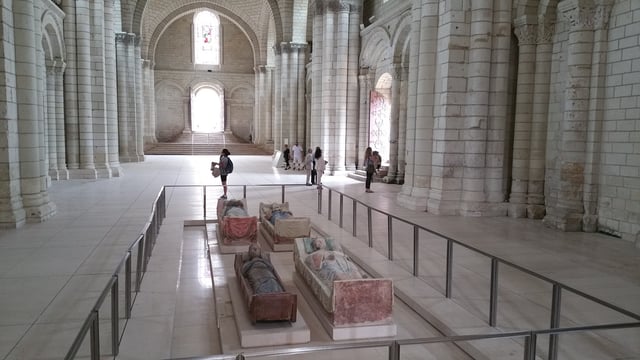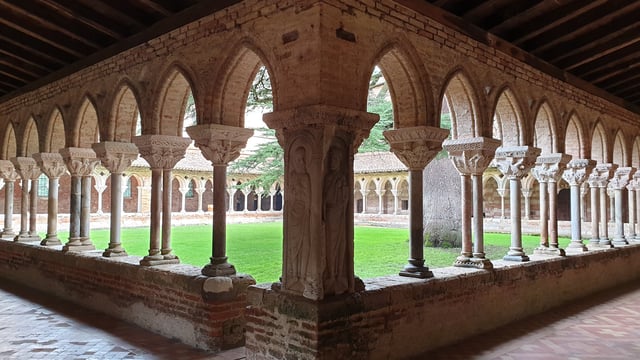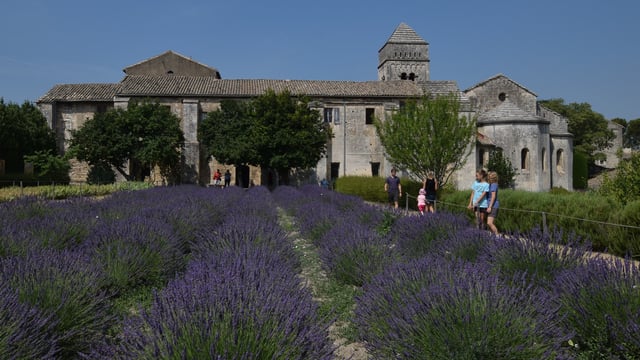Monasteries & Abbeys in France
Many of the abbeys and monasteries in France were established by wealthy nobles. Some of these would become centres of great intellectual and artistic activity. The Abbey of Saint-Germain-des-Prés in Paris had one of the most important libraries in Europe. During the French Revolution many of these institutions were destroyed or repurposed. Since then a number have been restored and attract many visitors. These are important historical landmarks that were influential in the political and cultural development of medieval France.
Abbaye aux Dames, Saintes
A former Benedictine abbey founded in 1047, Today the Abbaye aux Dames is a cultural centre that comes heritage and music. The focal point of the abbey is the 12 century Sainte-Marie church. Besides its striking ‘pine cone’ bell tower, the church is particularly known for its extraordinary Romanesque façade – one of the finest examples of Romanesque art in the region. Over the years the abbey has suffered greatly due to numerous wars and fires. It was fully restored in the 1970s an 1980s, when nuns cells were converted into hotel rooms.

Abbaye Notre-Dame du Bec
The abbey was founded in 1034 by Helloin, knight of Count Gilbert de Brionne. The monastic buildings have been destroyed and rebuilt many time, owing to natural disasters, the 100 Year’s War, the Wars of Religion, the French Revolution and more recently WWII. Despite this the monastic community still survives today, having raised a Pope, three archbishops of Canterbury and numerous bishops. The abbey church and the park are freely accessible, but guided tours are provided to the church, cloister and grand matins staircase (plan ahead for these).

Abbaye-aux-Dames
Founded as a monastery for women by Mathilda of Flanders following her marriage to William, Duke of Normandy. And it was here that Mathilda was laid to rest: her tomb can be seen in the choir. The abbey church was built in a typical Romanesque style and dedicated to the Trinity. In the ceiling of the apse is a restored but spectacular 18th century fresco that depicts the Assumption of the Virgin Mary. The original spires were destroyed in the ‘Hundred Years War’, and replaced in the 18th century, otherwise much of the church is original.

Abbaye-aux-Hommes
Founded by William the Conqueror in 1059 as a monastery for men following his marriage to Mathilda of Flanders. The Gothic abbey church is dedicated to Saint-Etienne, and has the tomb of the Duke of Normandy in the church’s choir. Although much of the 11th century church is original, the monastic buildings were destroyed in the 16th century and rebuilt in the 18th century. Today these buildings are used for the Hôtel de Ville. Daily guided tours of the Abbey are provided free of charge.

Abbey of Saint Wandrille
Also known as Fontenelle Abbey, the Abbey of Saint-Wandrille is a functioning monastic community, and one with a long and distinguished history. The Benedictine abbey was founded in 649 by Wandrille. Forty monks from Saint-Wandrille, including Wandrille himself have been sanctified. The monastic buildings have been repeatedly destroyed, by the Vikings and a World War, natural causes and a revolution, but each time it has been reconstructed. The ruins and the church are open to the public, guided tours include other parts of the abbey.

Bernay Abbey
Founded in around 1013 by William the Conqueror’s grandmother, Judith of Brittany, Bernay’s abbey is the oldest surviving Romanesque abbey in Normandy. Following a period of decline due to religious wars and peasant revolts, the abbey experienced a renaissance in the 17th century. This did not last long, by the start of the French Revolution there were only five monks. After the revolution the various buildings were used to house the town’s various administrative offices, including a court and prison. The latter ceased in 1950. Today a town hall and a museum of fine arts occupy parts of the abbey.

Cerisy-la-Forêt Abbey
Cerisy-la-Forêt Abbey was founded by Saint Vigor around 510. Although the Norman invasions of 9th century resulted in much destruction, the abbey began to prosper in the 11th century as a result of its influence over nearby abbeys. The 11th century saw a significant rebuilding. During the Hundred Years’ War the abbey was fortified and temporarily under English control. As a result of protestant seizure and fire, the abbey began to lose its influence and the buildings started to decay. It faced further dismantling during the French Revolution, with almost all of its buildings destroyed. Only the church and abbot’s chapel remain. The church is considered one of the finest Romanesque churches in Normandy. Displays in the Abbot’s Chapel recount the history of the abbey.

Cluny Abbey
Cluny Abbey is a former Benedictine monastery, that at its height of power and influence is said to have controlled some 1,500 monasteries around Europe. Founded in 910 by Duke William I of Aquitaine, it was built in the Romanesque style, with three churches built in succession from the 4th to the 12th centuries. Much of the monastery was destroyed during the French Revolution, and only the bell tower of the church and a few other buildings remain intact. A fascinating tour through the various buildings that have survived, making use of different media and display techniques, is available and a must see for anyone with an interest in the history of France and religion in Europe.

Fontenay Abbey
Founded in 1118 by Saint Bernard, Fontenay Abbey is one of the oldest Cistercian monasteries in Europe; and is now a listed UNESCO World Heritage Site. The abbey has retained its Romanesque style, with the exception of the refectory which was destroyed in 1745. An optional guided tour or enables you to see the very well preserved church, dormitory, cloister, council room, heating room, abbot’s lodgings, and the forge.

Fontevraud Abbey
Founded at the start of the 12th century, there were both men and women at the abbey, all governed by an abbess. Eleanor of Aquitaine made the abbey her residence. She and her husband, Henry II King of England, their son, Richard the Lionheart, and Isabella of Angoulême are buried in the abbey church. After the French Revolution the abbey became a prison. Today much of the abbey is open, the priory is a 4* hotel. A museum of Modern art will open soon, with over 500 works of 19th and 20th century European artists.

Hambye Abbey
The abbey was founded in 1145 by Guillaume Painel, the lord of Hambye, with a community of reformed Benedictine monks. It takes about 100 years to build the monastery by which time it started to exert influence throughout Normandy, Brittany and England. The community was all but decimated during 100 Year’s War, and by 1780 the abbey was abandoned and used a source of stone. It was not until the mid 20th century that restoration and conservation work took place, making the historic site a popular attraction.

Jumièges Abbey
These picturesque ruins have been described by many as the most beautiful ruins in France. Although founded in 654 by Saint Philbert, the ruins that we see today are the remains of successive abbeys built, destroyed and rebuilt over the centuries since, such was the importance of this religious centre. The abbey was burned by Norse Vikings as they conquered Normandy between 841 and 940 AD, then rebuilt and consecrated in 1067 in the presence of William the Conqueror


La Lucerne Abbey
Founded in the 12th century, Lucerne Abbey is one of the oldest Norman Premonstratensian abbeys. Although the site has benefited from extensive restoration projects in the 15th , 17th and 20th centuries, the original Romanesque and Gothic character has been largely maintained. Visitors are able to follow a set path to discover the highlights of the religious complex including the abbey church and its cloister, the Anglo-Norman tower and the dovecot. Guided tours are also offered by members of the monastic community.

Moissac Abbey
Legend has it that the Saint-Pierre Abbey in Moissac was founded by the Frankish king, Clovis I, in 506 AD to mark his victory over the Visigoths. More reliable historical records suggest the monastery was established in the 8th century. By the 11th century as a result of its association with the Cluny Abbey, it had become a wealthy religious centre in south-west France. The cloister is one of the largest and the best preserved Romanesque cloisters in Europe. The south portal is one of the largest Romanesque portals. Moissac Abbey is a listed UNIESCO World Heritage Site as part of the Pilgrimage to Saint-James of Compostela.

Monastery of Saint-Paul de Mausole
For about 1,000 years there has been a monastery near the archaeological site of Glanum. And for much of this time the community of monks has been known for taking in people with mental illness. The convent was nationalised after the French Revolution, and in 1807 it was sold to a doctor who then established a psychiatric asylum. On 8 May in 1889 Vincent Van Gogh was admitted, staying until 16 May 1890. Besides seeing his room, there is a walking tour of the gardens showing where he made some of his finest paintings. Also, a great place to see lavender.



















